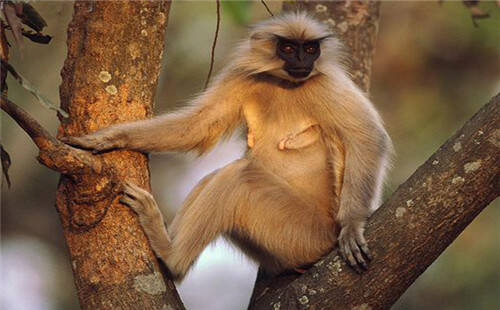Trachypithecus geei
IUCN
LCBasic Information
Scientific classification
- name:Trachypithecus geei
- Scientific Name:Trachypithecus geei,Gee’s Golden Langur,Yellow-crowned langur, golden langur, golden long-tailed monkey
- Outline:Primates
- Family:Monkey genus
Vital signs
- length:50-75cm
- Weight:9.5-12kg
- lifetime:No verification information
Feature
Fur ranges from dark gold to light yellow to cream with a solid black face
Distribution and Habitat
The golden leaf monkey is mainly distributed in Assam, India and Bhutan, from the Yarlung Zangbo River in the south to the Manas River in the east, from the Sankoshi River in the west to the Black Mountains in Bhutan in the north.
The golden leaf monkey inhabits moist evergreen and tropical deciduous forests, and lives in some river areas and savannas in Assam, India and Bhutan. They are very dependent on trees and live in the upper layers of subtropical forests in the south and temperate forests in the north. The altitude of residence also varies according to the geographical range. Located at an altitude close to sea level in the south and at an altitude of 3,000 meters in the foothills of Bhutan in the north.
Appearance
The head and body length of the golden leaf monkey is 50-75 cm, the tail length is 71-94 cm, and the weight is 9.5-12 kg. The overall shape is very slender, with long limbs and tail. There is a tuft of hair at the end of the tail, a pair of nipples on the chest or armpits, and the penis of the male is pendulous, with a penis bone, and the testes are wrapped in a sac. Males are significantly larger than females. There are no cheek pouches. The tail is very long, up to 50 cm. They spend most of their time in trees, using their tails to balance their bodies when jumping.
This species is easily identified by the color of their fur. They have dense, soft fur ranging from dark gold, light yellow to cream, with a pure black face, and bright hair behind the forehead and on the sides forming an incomplete semicircular facial disc. The body hair is golden yellow with a shiny sheen. The color of the fur varies in different parts of the body, with the top and sides of the head slightly darker a
Details
Golden Langur (scientific name: Trachypithecus geei) is also known as Gee’s Golden Langur in English. There are 2 subspecies.

Golden Langurs live in groups, with 2-12 in each group, usually consisting of one or two mature male monkeys and multiple female monkeys and their offspring. Active during the day, more active in the early morning and evening, resting in the midday heat. These monkeys spend most of their time in trees, using their tails to balance their bodies when jumping, and only rarely come down to the ground. They are mainly herbivorous, eating fruits, leaves, seeds, buds and flowers. They drink water from leaves during the rainy season.
Although little is known about the reproduction of golden leaf monkeys, it has been observed that they can mate and reproduce almost all year round. The birth is affected by climate and vegetation changes, and the birth is concentrated. In a gestation period of about 6 months, females will produce one baby. Male offspring will disperse to other places after adulthood or leave the group where they were born.
The main reasons for the species' survival were listed in 2003 as "plantations, grazing, destruction of non-woody vegetation for firewood and charcoal production, selective logging, wood collection, human settlement, deforestation, forest fragmentation, trade, killing by domestic dogs, habitat loss, high juvenile mortality, inbreeding, and local trade in live animals as pets and road shows. Due to road construction and other human activities (establishment of settlements), the northern and southern species have become isolated and completely separated, which has led to the loss of habitat fragmentation for survival. India is also expected to decline further due to mustard cultivation and other human activities, which pose a potential threat to the survival of the species. The golden langur is endangered, with a population of only 1,064 as of 2001, and their population is estimated to be declining due to the lack of young monkeys.
Due to habitat destruction, the population of the golden langur is restricted to fragmented forest patches, particularly in India. Habitat destruction is the main threat to this species in India. Hunting is prohibited in the Abhaya rubber plantation, but electrocution from power lines and hunting by dogs are local threats that are affecting the species population. A comparative analysis based on satellite images taken in 1988 and 1998 shows that the original habitat of the species in India has decreased by 50%. Although commercial logging is prohibited in the protected areas where the species lives, illegal encroachment and timber poaching have severely affected these forest reserves. Quarrying and its associated noise pollution, as well as artillery firing in the Bamuni Hills, may also have a negative impact.
In addition to natural habitats, the golden langur is also found in wildlife sanctuaries in India and Bhutan. In Bhutan, a combination of four different national parks and wildlife sanctuaries covers most of the area where the golden langur lives. In Assam, India, they live in two wildlife sanctuaries there, as well as parts of fragmented reserve forests, proposed reserve forests, and other non-forest areas.
Listed in the "Red List of Threatened Species of the World Conservation Union" (IUCN) 2008 ver 3.1 - Endangered (EN).
Protect wild animals and eliminate game.
Maintaining ecological balance is everyone's responsibility!








